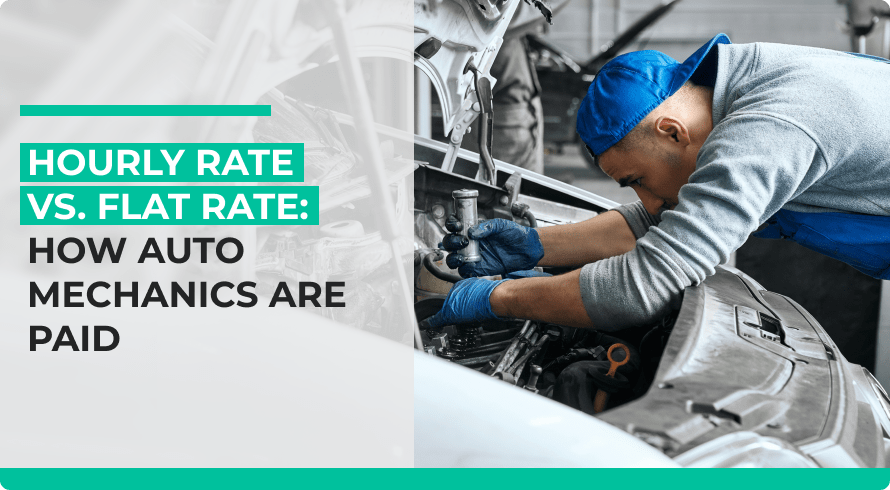Establishing pay rates for your techs is a crucial part of running a successful auto repair shop. You can always use automotive repair shop software to make it easier, but there are several ways to approach this process effectively.
In this article, we’ll do a deep dive so you can see what option best suits your shop. First, let’s focus on hourly rates.
Hourly Rate
An hourly payment schedule is fairly straightforward—techs are paid depending on their hours worked. More hours worked means more money paid, and often there is a base rate established for the hour.
For example, if a base pay rate is established at $20/hour and a tech works 40 hours per week for a job, their pay will come out to $20 x 40 = $800.
How an hourly rate affects mechanics
Getting an hourly pay rate has a number of advantages for technicians. These benefits include:
- Stable pay rate: Knowing what you’ll get paid at the end of the week can feel comforting, especially when jobs can be unpredictable.
- Added security for diagnostics time: You never know what kind of job you’ll get assigned as a technician. Some jobs can take a long time to diagnose service and repair needs, so knowing that your extra time will be rewarded is ideal.
- An incentive for better quality work: When there’s no rush to complete a job within a certain time limit, technicians can use the extra time to ensure everything works as it should.
How an hourly rate affects your shop
As a shop owner, there are a number of factors to consider before settling on an hourly pay rate for your techs.
- Quality of the job: When techs are paid for the time they work, they feel incentivized to work more and boost the quality of the job, which can greatly boost your shop’s image in the market.
- Your bottom line: Growth should always be sustainable, and you need to make sure technicians aren’t prolonging a job in order to earn more pay. Having auto repair software with a technician app can help boost transparency in this case.

Flat Rate
Flat Rate pay is calculated on a per-job basis. The employer calculates the approximate time that a job should take, and the mechanics’ pay is determined based on that.
Take this example. A car comes in with a repair job and the supervisor estimates that the job will take two hours to fix. In this scenario, the mechanic will get paid for two hours. That is their fixed pay, regardless of whether or not the job takes that long.
Under this method, store owners may use a labor matrix to ensure consistency and maximize profitability for each job. With flat-rate pay, it’s crucial to ensure accurate invoicing for each job to maintain clear and transparent billing. Utilizing auto repair shop invoice software can streamline this process, helping shop owners create detailed and error-free invoices while maintaining trust with customers.
How a flat rate affects mechanics
Mechanics are paid a fixed amount for each job, which can impact their performance in certain ways. This effect:
- Incentivizes mechanics to finish the job fast: Since techs are paid a fixed amount for the job, they are incentivized to finish the job quicker. As a result, this leads to a higher turnover for each tech.
- Ensures more compensation for similar jobs: Techs are paid based on the complexity of a certain job. That factor means depending on the jobs they take, a tech can work 40 hours per week and make significantly more than if they earned hourly rates for the same hours.
- Creates work flexibility: No two days have to be the exact same under a flat-rate pay system. Techs can work a lot one day and choose to keep it light and easy on another. This balance is very appealing to many mechanics in an unpredictable industry.
How a flat rate affects your shop
Flat-rate pay can have a number of effects on your shop. Let’s discuss a few:
- Higher average repair order(ARO) size: When techs try to finish the job as soon as they can, you can service more cars and significantly increase your ARO.
- Flexibility with payments: Having a different rate of pay for each job means you’ll have a different expense for labor every week, which you should take into account when planning financials for your auto repair shop.
- Pay only for the job: Techs won’t spend more time on a job than they need to, which means you won’t have to pay them for any socializing or non-work-related tasks they do at the shop.
- Encourage competition in your business: Friendly competition can be one of the best drivers of growth at a shop. By encouraging competition, techs work harder, take charge, and are more aware of business operations.
- No incentive to mentor younger techs: Being paid only for the jobs done would mean that there’s very little incentive to do anything else that could be of great value to the shop, such as mentoring the younger technicians.
In order to get the best rates for a flat-rate system, you’ll need to take advantage of your labor times. It’ll help you greatly to learn how to get the best labor times for your auto repair shop.

Warranty repairs
Approaching a warranty repair job is a lot different than a regular job. Often manufacturers will set out the estimated time and flat rate for a job. These figures are usually not as generous as the rates a service manager might set, and for a tech working on a flat rate, the compensation might be a lot less than what they’re used to.
It’s important to check the details of a warranty job and let the technicians know up-front what they’ll receive so that they can make the best financial decision.
» Looking to streamline your operations? Discover how our automotive repair shop software can help.
Closing thoughts
Setting the best pay rates for your techs isn’t a complex task, but it is an important one. Most auto repair shops usually have a combination of both systems that benefit the tech and the shop.
Ultimately what matters is the attitude and nature of your technicians. Fast-paced and driven workers might be more suited to a flat-rate pay system, whereas techs who prefer a slower pace would prefer an hourly rate. Make sure to communicate with your technicians to see what works best for them.
How are flat rate hours calculated?
Flat rate hours are calculated based on the approximate time a designated amount of time a repair order should take. This rate is determined before a job is started and will represent what a mechanic gets paid.








